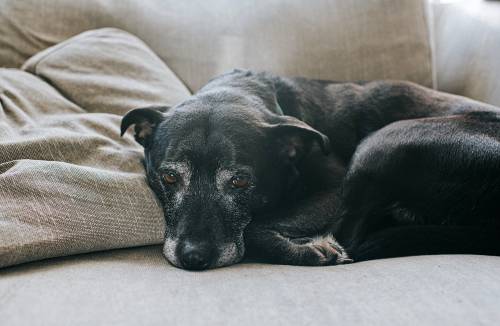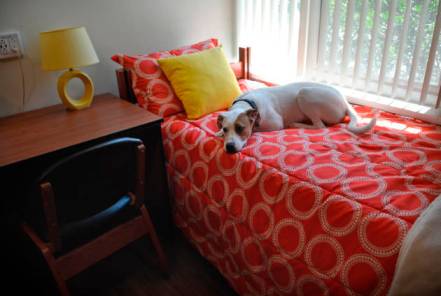Has your older dog developed some lumps and bumps on his skin? If so, these may be caused by your dog’s normal aging process. While most bumps and lumps are benign, it is possible they could be malignant.
Connect with a verified veterinarian in minutes. Licensed vets are available 24/7 to answer your questions. No need to worry about your furry family member.
In this article, we’ll take a look at some of the most common causes for a senior dog’s lumps & bumps and what you need to do about them. Let’s get started!
What are Senior Dog’s Lumps & Bumps?
Lumps & bumps on an older dog are completely normal. As dogs age, they can develop some irregularities in their skin. Most of these are harmless; however, some can be cancerous. How can you tell between a harmless lump/bump and one that’s cancerous?
As a pet parent, you really can’t tell if a bump or lump is harmless. However, the vet will be able to help. They’ve been trained to determine if lumps and bumps are normal or malignant. We’ll get to the diagnostic methods the vet uses later in this article. Right now, we’ll focus on the different types of lumps and bumps an older dog can develop.
Hives: these are also referred to as urticaria. Dogs that have environmental and/or food allergies can develop hives. Hives are a sign of an allergic reaction. They appear as red, raised, round areas or weals on the skin that are extremely itchy. The skin under the red areas will become more swollen and raised. The vet may choose to treat hives with an antihistamine and/or corticosteroids to give your dog relief.
Histiocytomas: these are ulcerated nodules, which look like a red lump. These are usually found on the dog’s legs. Histiocytomas may go away on their own or stick around for a while. These should always be checked, as they can look very similar to some types of skin cancer.
Warts: these may look like skin tags or several small lumps together in one place. They may be found on the head and face. The cause is papillomavirus, which is very contagious. Dogs can easily pick this up at the dog park, the kennel, and more. Warts usually don’t require treatment and will go away on their own. The vet may consider removing a wart if it is causing your dog some irritation.
Abscesses: these are swollen lumps under the skin, which may contain fluid or pus. These are most often caused by some type of infection. The vet may need to drain an abscess, clean it, and then prescribe antibiotics for your fur baby.
Lipomas: are fatty lumps that may develop under an older dog’s skin. These are usually around and soft. While they’re not cancerous, they can grow large and make it difficult for a dog to move around.
Mast cell tumors: this is a type of blood cell tumor of the immune system. These are most often found in dogs over the age of eight years. They can look like other types of tumors, which means they should be checked as soon as possible.
Fibrosarcomas: also referred to as soft tissue sarcomas, these tumors tend to be invasive in the connective tissue of the skin. These tumors grow fast and can spread.
Melanoma: dogs are also prone to this type of skin cancer, just like us. This type of skin cancer in dogs is also very aggressive and needs to be treated as soon as possible.
Squamous cell carcinomas: this is another type of skin cancer that is often found in hairless areas or areas of the skin that doesn’t have much color. They may appear as crusty, raised sores.
Breast cancer: this type of cancer is most often found in female dogs who have not been spayed. However, male dogs can also develop this type of cancer.
Osteosarcoma: is a type of bone cancer, which is most often found in male dogs.
Ticks: can also cause lumps and bumps on dogs. As the tick eats, it becomes larger and, when gorged, may appear as a skin-colored lump on the skin.
When you find any suspicious or concerning lumps and bumps on your older dog, it’s time to call the vet. Early diagnosis and treatment are crucial when it comes to any form of cancer. It’s also important for other conditions such as infections, ticks, and more.
How Does the Vet Diagnose Lumps & Bumps on an Older Dog?
There are several ways your vet can determine the type of lump or bump on your older dog. The first thing the vet will do is a physical exam, which focuses on the lump/bump. The vet will also ask questions such as when the lump/bump first draws your attention, whether the lump has changed in size/color, and if your dog is acting differently. This could include your dog’s activity level, appetite, etc.
Along with the physical, the vet may also run lab work and some other tests, which can include:
Impression smear: this test looks at the fluid or discharge that may come from a bump. The vet may rub a slide over the area, stain the fluid on the slide, and then exam it under a microscope.
Fine needle aspiration (FNA): for this test, the vet will insert a fine needle into the lump and remove cells that are inside. The cells will be put onto a slide. Next, they will be stained and reviewed under a microscope. The vet may choose to send the sample to a lab for additional examination. Some dogs may need to be sedated for this procedure.
Biopsy: a biopsy generally involves giving your dog a sedative or an anesthetic. Then the vet takes a small biopsy of the lump. This may involve removing only part of the lump or all of it. The vet will make that determination. The lump is then sent to the lab for examination.
Lab test: fluid will be removed from the lump and then sent to a lab for examination. The lab will check for any type of fungal or bacterial infection.

Review symptoms, medications & behavior to keep your pets healthy with a Vet Online in just minutes.
Ask a Vet Live NowTreatment for Lumps & Bumps in Senior Dogs
Treatment of your dog’s lumps/bumps will depend on the diagnosis. For cancerous tumors, the vet may use cryosurgery (freezing with liquid nitrogen), radiation, chemotherapy, a lumpectomy, and more.
As you can see, lumps & bumps can be normal. Most of them are benign; however, it’s also possible for your older dog to have some type of cancer-causing his lumps and bumps. For this reason, it’s best to call the vet when you first notice any changes like these in your dog’s skin. You may just save his life!
Connect with a verified veterinarian in minutes. Licensed vets are available 24/7 to answer your questions. No need to worry about your furry family member.

Julie
Julie is a graduate of the University of North Carolina, Wilmington, where she studied Animal science. Though contrary to the opinion of her parents she was meant to study pharmacy, but she was in love with animals especially cats. Julie currently works in an animal research institute (NGO) in California and loves spending quality time with her little cat. She has the passion for making research about animals, how they survive, their way of life among others and publishes it. Julie is also happily married with two kids.
Review symptoms, medications & behavior to keep your pets healthy with a Vet Online in just minutes.
Ask a Vet Live Now



